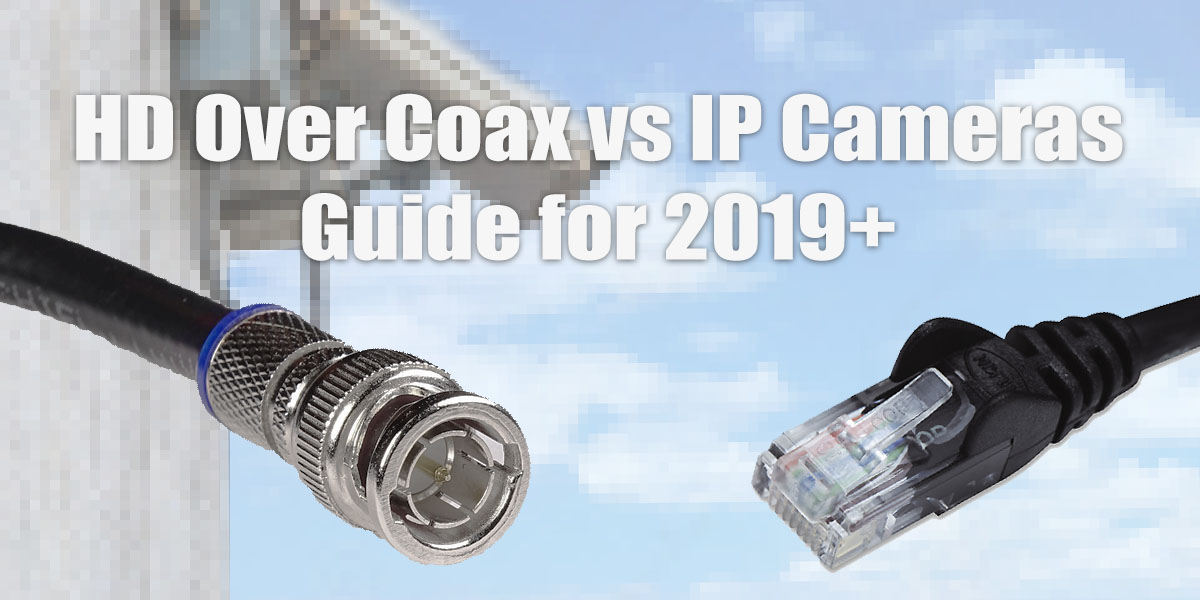HD over Coax vs IP Cameras in 2019 / 2020
A Comparison Guide for 2019-2020
Many “IP Cameras vs HD over Coax” comparisons that you see online more or less sway towards which ever technology the company sells that posted the article. Some may have been accurate at the time of their writing, but today can be misleading for people looking for information today.
You may hear that Coax is used only for older analog video technologies while Ethernet or IP is the only way to upgrade or install a new video system. But everybody ignores or forgets the capability of the coax cable that runs to your home and provides the 300+ HD channels AND high speed internet! If old coax cables can do that, why would it be bad for a camera video system? Coax itself may be old, but the technology that connects to it is just as up to date as any IP based system.
The introduction of new HD over Coax technologies over the last 5 years, we have been exposed to many new technologies and alternatives that make Coax video quality just as good as your standard Ethernet/IP camera. There are many pros and cons to using both, let’s go over the information for you to choose what is best for you.
What are IP Cameras?
IP cameras are also known as Ethernet Cameras, or Network Cameras. They are very versatile cameras that use your existing network to encode/compress video and send the information over the network to what is known as a Network Video Recorder (NVR) to be saved. They are available with many options as they can be installed with hardwire cat5e/cat6, or connected via WIFI signal for wireless transmission. IP cameras often offer impressive high resolutions like 4K or even 360 degree viewing cameras at 16 Megapixel.
- Network / IP Cameras: Encodes/Compresses Video Data and sends via IP over the network to a NVR.
- Offers the highest megapixel performance available on the market.
- One very high megapixel camera can replace multiple lower resolution cameras.
- Small WIFI / Wireless installations can be finished in just minutes
- Requires some IT knowledge.
- Best used with Cat5e or Cat6 ethernet cable.
IP cameras also have Power-over-Ethernet (POE), which allows power/video and data to be transmitted over a single ethernet cable which can make wire installations simple and easy to install as you do not have to bother with traditional camera power supplies.
What are HD over Coax Cameras?
Unlike most IP cameras, HD over coax has many different available technologies. There are 2 main categories to remember when thinking about HD over Coax:
- Analog HD: analog based high definition technologies like HD-TVI, HD-CVI, and AHD.
- These are most commonly used as a low cost easy way to upgrade existing installation that use old analog cameras. You use the same coax, same power and you can upgrade to 1080p up to 4K resolutions without changing any wires.
- Best used with RG59 or RG6 coax cable.
- Digital HD: higher quality digital HD over coax known as HD-SDI, 3G-SDI and EX-SDI.
- These are high end Real-Time uncompressed signals for the best video quality, a standard taken directly from Television Broadcasting. When uncompressed quality is most important, this is the best there is.
- This type of signal is best when you need the cleanest video image for identification or image processing without compression artifacts as you have the ability to pull the raw camera feed before compression. (basically any fast moving applications where compression artifacts can be a problem).
- Best used with RG6 coax cable.
These latest technologies also offer 4K resolutions but video is transmitted from the camera through coax to a Digital Video Recorder (DVR), very similar to IP cameras and an NVR.
Here is a comparison table with pros and cons (lengthy I know, sorry)



